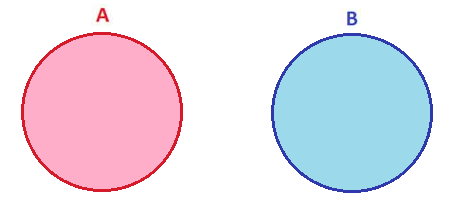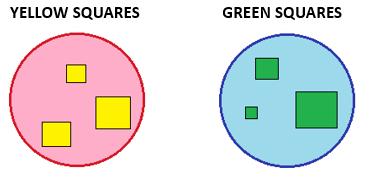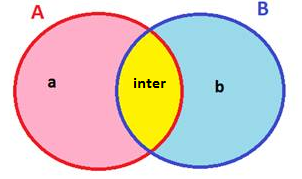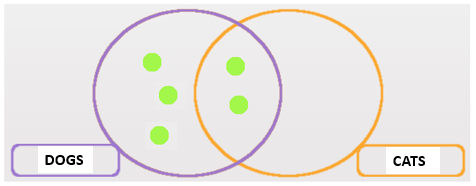In today’s post, we are going to talk about Venn diagrams.
Venn Diagrams are used to graphically show the grouping of elements in sets, representing each set in a circle or an oval. We are going to look at and study examples of 2 sets: Set A and Set B. These two sets show 2 elements that cannot have anything in common.
These two sets show 2 elements that cannot have anything in common.
For example, set A consists of yellow squares and set B consists of green squares. The Venn diagram would look like this: There is another type of Venn diagram which is the one with a common area between sets A and B. This area is called an intersection (inter).
There is another type of Venn diagram which is the one with a common area between sets A and B. This area is called an intersection (inter). For example, set A consists of squares and set B consists of green shapes. The diagram would look like this:
For example, set A consists of squares and set B consists of green shapes. The diagram would look like this:
- There are squares in the pink area (A).
- There are green shapes in the blue area (B).
- There are squares which are green in the yellow area (intersection).
Let’s look at another example, one which appears in Smartick’s logic section:
We asked 7 of Louis’ friends:
How many of you have dogs at home? 5 raised their hand.
How many of you only have cats at home? 2 raised their hand
How many of you have dogs and cats? 2 raised their hand.
According to the survey, would you be able to tell me how many only have dogs at home?
We are going to analyze the information:
- 5 people have dogs at home but that doesn’t necessarily mean they only have dogs, so set A consists of 5.
- 2 people have cats at home, therefore set B consists of 2.
- 2 people have both cats and dogs, therefore the inter consists of 2.
They are asking us about people who only have dogs, and that information is in area A.
We put two little balls in the intersection zone representing those who have both cats and dogs. If 5 people have dogs, and we already know that 2 have both cats and dogs, we can do the subtraction to find out how many only have dogs: a = 5-2 = 3
If 5 people have dogs, and we already know that 2 have both cats and dogs, we can do the subtraction to find out how many only have dogs: a = 5-2 = 3 Answer: 3 people only have dogs at home.
Answer: 3 people only have dogs at home.
We hope you liked this post. You can learn more about Sets and Subsets on this previous post on our blog.
And you can try Smartick for free to learn more elementary math!
Learn More:
- Working with Venn Diagrams in Smartick
- How to Group Sets and Create Venn Diagrams
- Learn about Set Theory and Study Techniques
- Introduction to Sets and Subsets
- Manipulative Games to Practice Set Theory







